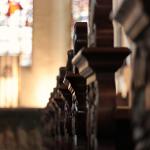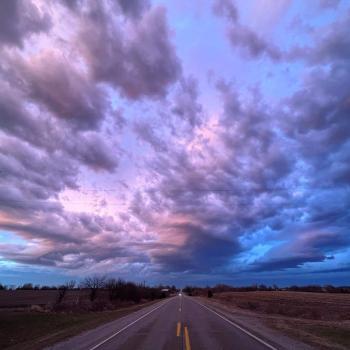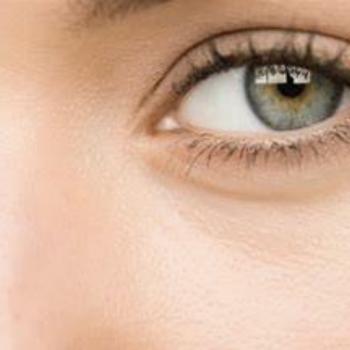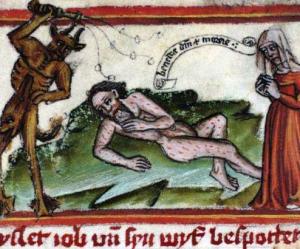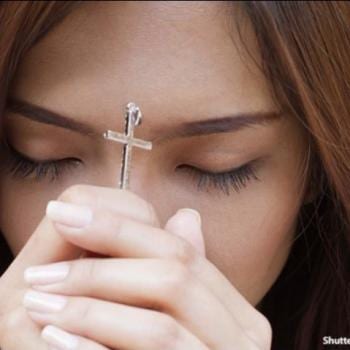The theater is tiny, curtained on all sides, with carpeted benches rather than seats. There I perch, legs curled sideways, ankles crossed.
One film after another. Jugglers and clowns. Pointy-breasted showgirls. A rattlesnake. A painted cave. Pina Bausch, dancing en pointe with cow flesh in her slippers.
My neighbors gasp, and sigh. They exhale wonder, and it fills the room like smoke.
I grit my teeth, head turned at an ugly angle, my body twisted and tense. Supremely unreasonable, I am a crooked woman with crooked eyes, crooked sight, stubbornly refusing to look away.
To see in three dimensions, the viewer needs two functioning eyes, placed at a slight distance apart, with the ability to focus synchronously on a single object. The brain takes these two differing signals, finds their convergence, and creates a picture with depth. Binocular vision, it is called. Humans have it, and eagles, and wolves. Predator species, mainly, although sheep have it as well.
I don’t.
A quirk of genetics gave me a weak eye and stronger eye, the weak eye turned slightly inward. As a result, my brain can only process one image at a time. A surgery in my teens corrected the cosmetic misalignment, but if you are very observant you might notice that I keep my head cocked slightly off-center. This tiny adjustment means that my good eye always has an optimal view of what is in front of me. A binocular field of vision can extend up to one hundred eighty degrees to either side, but mine tops out at a narrow ninety to one hundred degrees. Once decoded by my brain, the picture I see is flat as a photograph.
Depth perception, for me, requires motion. Species with monocular vision (myself, squirrels, and other prey) predominantly perceive distance and depth through something called motion parallax, defined as the speed at which objects appear to move in relation to the movement of the observer.
It’s easier to understand if you picture yourself as a child, sleepily gazing out the window of your mother’s car. The dark shapes of trees whip past. The street sign in the distance appears to approach slowly. The moon travels with you, a fixed point in the racing world. Your brain understands what all this means. Near, farther, farthest. Parallax.
Motion parallax is enough for most of us to avoid wolves, or sharks, or walking into telephone poles, but it is not a tremendous help when it comes to playing volleyball in gym class, and it functions not at all when it comes to the illusion of 3D, in art or otherwise.
So, what am I doing here? Why am I spending an hour with art I cannot see?
A docent hands me a pair of red and green tinted glasses.
All experiences of art consist of both the seen and the unseen. We approach the work as limited beings, all a little broken, a little blind. Ready to receive, we strain to see. We believe we comprehend, or we struggle and are frustrated.
I don my cardboard spectacles and approach an exhibit. My view is red, with only a blurry hint of green in the left corner, like a drop of watercolor paint.
I squint. Strain. Glasses on, glasses off. Cocking my head this way and that. What if I hold the glasses out? Sideways? Upside down? Nothing. Of course, nothing. It would be unreasonable to expect otherwise.
Perception is subjective, so I have heard, so I dispose of the glasses and try to value the uniqueness of my own vision. Those around me are delighted, laughing, grabbing at the empty space.
Forget them. What do I see?
Dozens of photographs mounted side by side. Blurred paintings, images and patterns, red and green lines always slightly askew.
My view, I reason with myself, is as legitimate as any. There is no such thing as true sight.
A small boy next to me is elated as a screen shows him a mid-century ballplayer, pitching a baseball toward the camera again and again. His grin pierces the veil of my philosophy.
Spoilsport.
I move on to the next gallery, which is larger, empty, and quiet as a church.
***
Some bird species optimize their depth perception by bobbing their heads. Up and down they go, their tiny brains rapidly calculating fine ratios of differentiated movement. Me, perched high in the choir loft at Sweetest Heart of Mary, I sway.
My habit is to shift my weight to one side, then the other, then carefully forward and back, while my field of vision swoops and soars. With my good eye, I follow the relative movement of the columns, the statues, the soaring arches and the stained glass. Quick as a bird, my brain processes what I can see, calibrates signals from my inner ear, measures the echo of my voice as it reverberates, and combines them all according to its own mysterious algorithm.
I recognize what is below me, above me, before me. On my right side and my left. Enormity, obviously, and beauty, but mostly empty, echoing space, as still and imposing as the gallery of a vast museum.
Sweetest Heart of Mary Church, where I currently serve as a musician, is a gorgeously gothic mess in a nearly abandoned corner of Detroit. The migration from the city over the past generation or three has done its work, and where there was once a thriving community of blue-collar households, family-owned shops, and parish schools, there are now hulking industrial complexes, abandoned warehouses, a juvenile hall, and a few more austere buildings belonging to the city.
In its heyday, Sweetest Heart was an ethnically Polish parish established a block away from another ethnically Polish Parish. Two eyes, a slight distance from each other, focused on the same object.
Or rather, that would be the analogy I would use if it were not slightly misaligned. Sweetest Heart of Mary does, in fact, exist a block from another Polish parish, St. Josaphat, but also two blocks from a third, St. Albertus. All three constructed in the 19th century to serve the city’s booming population of Polish Catholic immigrants, they exist now in various states of disrepair.
St. Albertus was deconsecrated in 1985. It unlocks its doors occasionally, and tourists of urban decay can walk down its echoing aisles, necks craned towards the cracked ceilings. Supported financially by an organization called the “Polish American Historic Site Association,” it hosts infrequent special Masses and regular fundraising suppers.
St. Josaphat is clustered with Sweetest Heart into a single parish: “Mother of Divine Mercy.” Although there are still a handful of devoted congregants, it hosts only one mass per weekend– a Novus Ordo in Latin—which is never more than lightly attended. and a handful of modest weddings. It has a makeshift organ and cracked plaster. Its days, one assumes, are numbered.
Sweetest Heart was built between these two, like the mystical third eye. It survives to serve a few hundred families, most of whom commute from the suburbs for Sunday masses. On Christmas and Easter, it is crowded with generations and generations of middle and upper-middle class Catholics, both faithful and semi-lapsed, many or most with last names ending in -ski. The most photogenic of the three churches, Sweetest Heart of Mary is maintained substantially with the income from dozens of elaborate weddings per year. Funding for the current steeple renovation is secure.
Three churches, three objects, three points of reflected light, fixed in place as the city moves on. One stationary. One barely creeping. One moving forward.
Parallax.
When these three churches opened their doors well over a century ago, they were built specifically to inspire and express the transcendent belief of migrant people. I am humbled, grateful to serve their memory with my own art. In my limited way, I appreciate all that they created in faith.
In hindsight, it was only a few short (and long) years ago that my throat vibrated and my vision swayed to the tune of my own devotion. Time and trouble moved me along despite myself, and for whatever reason, my sight is weaker now, narrower. On a bad day, when I am feeling particularly unreasonable, it is flat. Flat as a photograph. Maybe I’m just a little too crooked.
I still sing from the loft, of course. I am there to serve as an artist, suspended among the work of hundreds of faithful artists long dead, doing my best for the devoted who remain. I sing, and sway, and search my own mind for remembered visions, hoping to find the convergence of what I see, and what I have seen. From above I can see the faithful, heads lifted, eyes wide open in wonder.
It all must look pretty cool in 3D.
***
Back at LACMA I queue for fifteen minutes before another docent allows me into a theater. Handing me a fresh pair of glasses, he explains that inside are about forty minutes of film clips playing on a loop, a history of 3D filmmaking. Inside, I claim a bench where I sit and stare for ten, twenty, forty minutes.
I don’t even know what I am hoping to see.
Restless, I find myself shifting. Swaying. Despite myself, I am doing my best to see what those around me cannot help but reach for. Straining, I am twisted, squinting, cockeyed.
Mickey Mouse. Errol Flynn. Godard. A butterfly migration.
A butterfly migration. That’s when it happens.
For a moment only, half a moment, I see something. A flash of gold, then detail, shape. The light creates a form, my eyes receive a reflection, my brain sculpts her the air, and my soul recognizes her. Convergence. In the liminal space between my eyes and the screen, a single butterfly is with me.
But, really with me.
Hello, you.
I am seeing. I have never seen.
I am seeing. I have never seen.
I gasp.
I reach out to grasp at empty space, but I am not disappointed.
Resonance is not tangible. Reflection cannot be held in place. Near, farther, farthest, none of these matter, because I am her, and she is me, and we are convergence. We are the third eye, the fixed moon, the baseball thrown again and again, the boy who will never stop trying to catch it. We are parallax.
A flash, a quick cut, a new film.
Goodbye, I tell her, or maybe, see you later.
All my crooked eyes see now is flickering light, flat and finite as the projection screen. Exhale.
Rising, I remove my glasses and duck through the dark curtain back into the gallery, then out into the bright afternoon. I am floating, driven by hope, casting my sight before me, measuring and calculating.
If blind eyes can be made to see, even for a single moment, it is reasonable to believe that they might see again. It is reasonable to believe there may be an invisible depth, a dimension beyond my broken sight. It is reasonable to believe that maybe it waits for me.
Maybe she waits for me.
Maybe all I have to do right now is move forward, squinting at what my eyes can see near, farther, way off in the distance. Measuring. Calculating. Doing my best.
Hoping for convergence, or conversion. Hoping that someday, someday I might reach, fight, fly beyond the flatness of my own perception.
Maybe I will still be singing then. Suspended, but not in emptiness. Surrounded. Flashes of gold before me, below me, to my right and to my left. Flying into the light. Swooping to one side, then the other. Vision that can’t be measured in degrees. A butterfly. A million million butterflies, and me.
Me, and her, and a great migration.
*****
Theresa Marier Weiler is a Detroit-area musician and educator.



